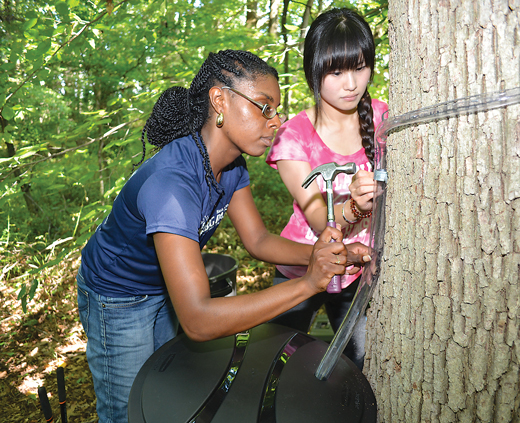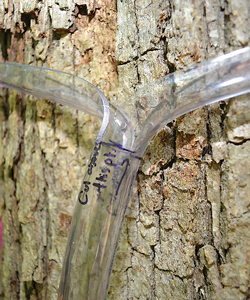
The Urban Raindrop
OUR STUDENTS | Imagine a raindrop falling from the clouds and onto a treetop, flowing first across a leaf, then trickling along a branch, and finally dripping down the trunk all the way to the ground.
That one drop, multiplied many times, rainstorm after rainstorm, city across city, has the power to do great good—as well as quite a bit of harm. Depending on the type of tree it travels down and the shape of the “forest” it found, a raindrop might be carrying pollution away from the trees… or aggravating urban flooding problems. It might be fostering healthier plants by distributing crucial nutrients… or simply inundating sewer systems. It might be guided by the tree in such a way that groundwater supplies are recharged… or simply dumped onto a parking lot to puddle and stagnate.
Asia Dowtin, EOE12M, 17PhD, wants to tell the untold stories and unimagined journeys of that humble raindrop. With funding from the National Science Foundation, American Water Resources Association and UD’s geography department, the Roosevelt, New York-native and doctoral candidate is focusing her research on the esoteric and largely unseen dynamics of “stemflow”—the intricate interactions between raindrops and trees.

And she’s doing it one drop at a time. With rainwater collectors at different locations within such “urban forests” as Wilmington, Delaware’s Rockford Park and Alapocas Run State Park, she and faculty adviser Delphis Levia, professor and chair of geography, will gauge the water-management capabilities of different types of trees in different locations—some out on the edges, others tucked closer to the center.
Armed with the data she will collect over the next year, Dowtin will ask: What kinds of nutrients—and which pollutants—are being carried down from the treetops along with the rain? What is the sheer volume of water being delivered to the ground over time by different types of trees and different densities of forests? Is there a difference in volume and quality from the edge to the center?
“In urban areas, stemflow is of particular importance, because we have all this stuff settling onto the forest canopy,” she says. “We have atmospheric pollutants from cars, we have industrial emissions, we have highways that cut through cities. Then, when it rains, this stuff is washed off the surfaces of the trees. Stemflow is really important in urban areas because it concentrates all that water into a small area at the base of the forest.”
Why that occurs is what she’ll soon uncover.



